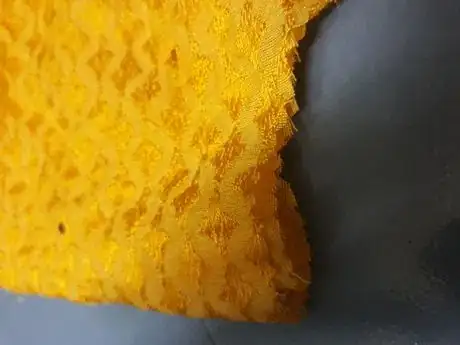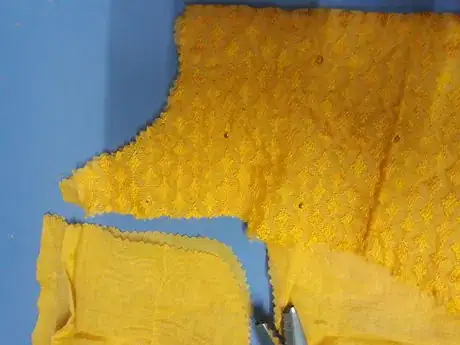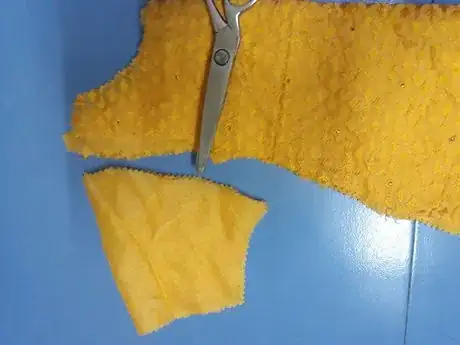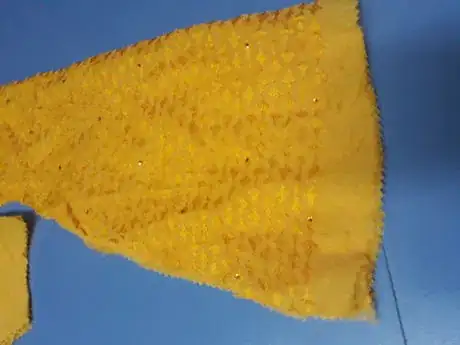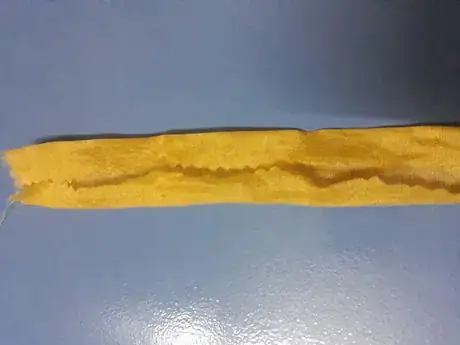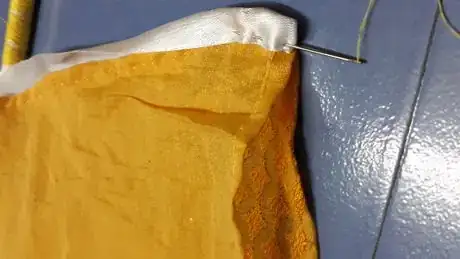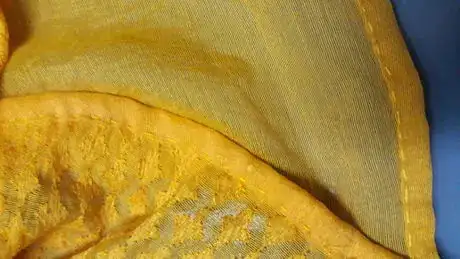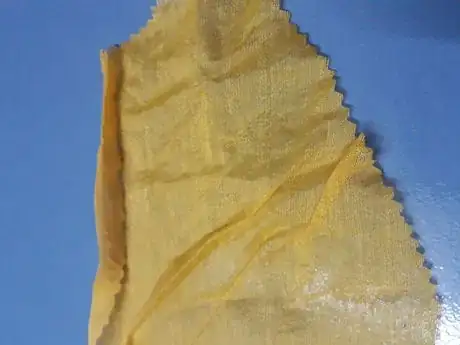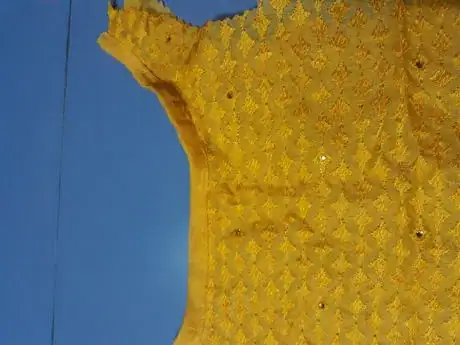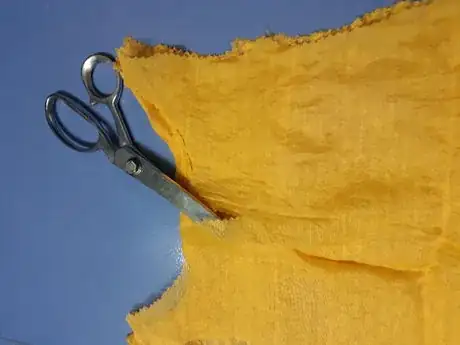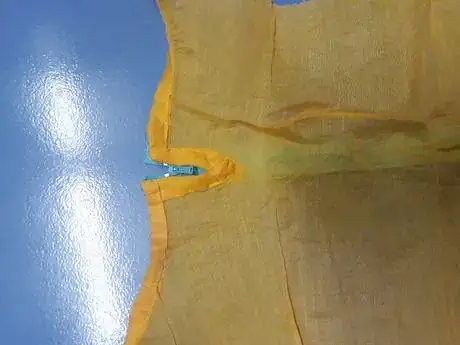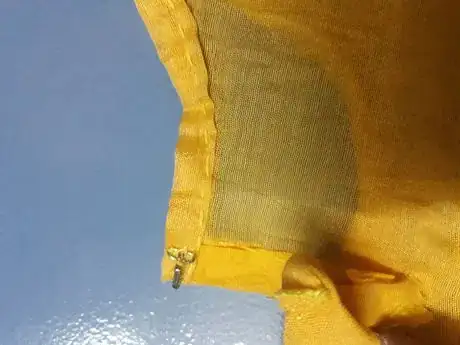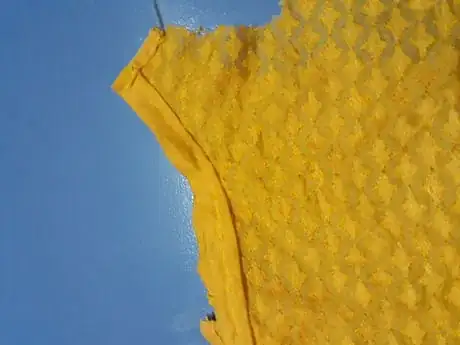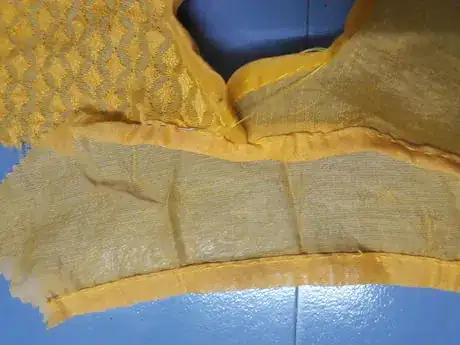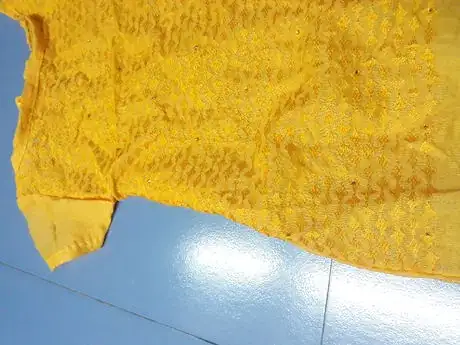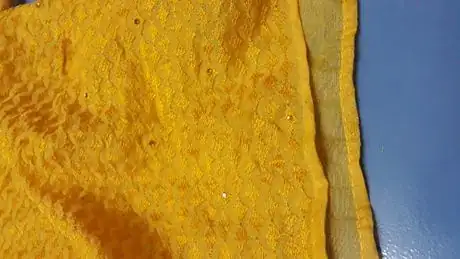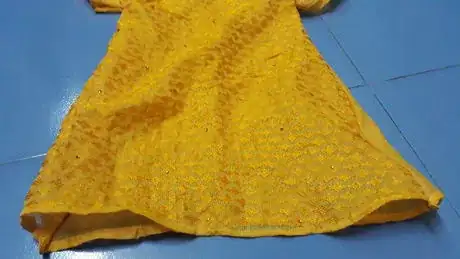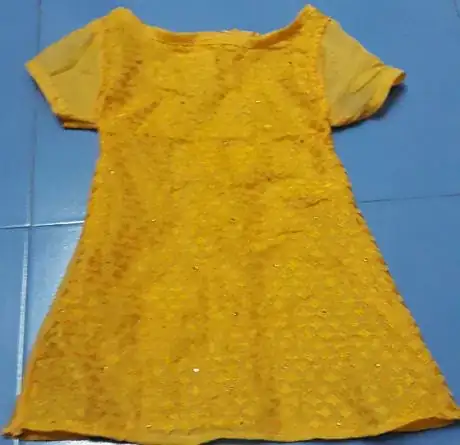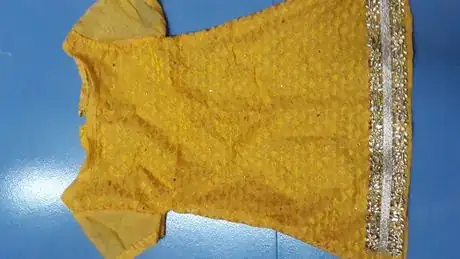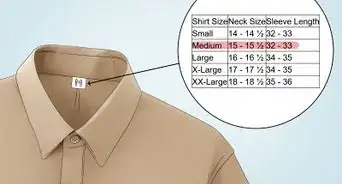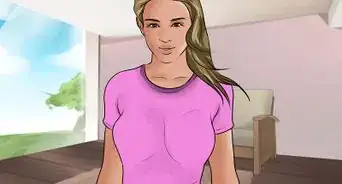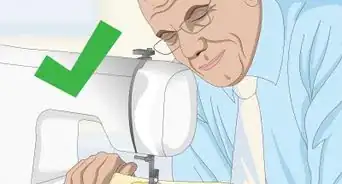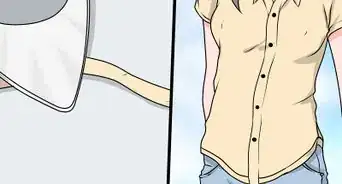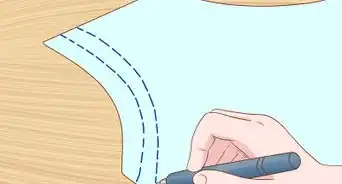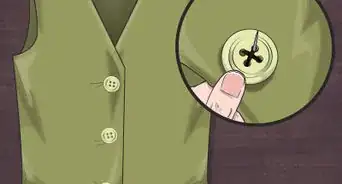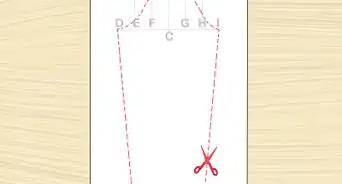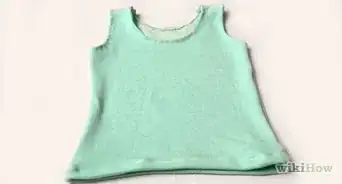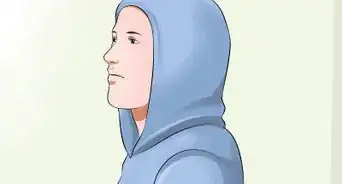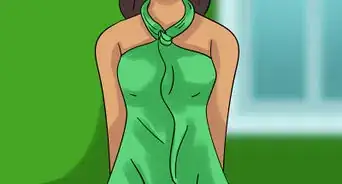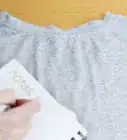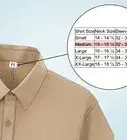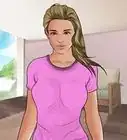X
wikiHow is a “wiki,” similar to Wikipedia, which means that many of our articles are co-written by multiple authors. To create this article, volunteer authors worked to edit and improve it over time.
This article has been viewed 26,872 times.
Learn more...
Do you want to make a comfortable kurta? You can make this beautiful tunic for yourself as is, or you can turn it into a shorter kurta i.e. a kurti, or an anarkali top, or even a dress. You can hand stitch with a needle and thread or use a machine. Opt for the fabric and print of your choice, and follow along with the steps below to get started.
Steps
Part 1
Part 1 of 8:
Preparing the Fabric
-
1Wash the material if needed to prevent shrinking and fading. To help retain the colour of the fabric, you can wash it before you begin. Put the fabric in a half-full bucket of water and add about a couple of tablespoons of salt in it (about 1 tablespoon of salt for each 3 to 4 meters of the fabric). Mix until the salt dissolves and the fabric is completely soaked in the salt water. Leave it in the water for 5 to 6 hours so that the colour of the fabric will be retained in the future.
- This step is optional but will help make a long-lasting garment.
- You can also wash the fabric thereafter in plain water or with detergent, if you like.
-
2Iron the fabric. After it dries, iron it so that it's smooth and you can more easily mark, cut, and stitch. Skip this step if there are no creases in the fabric anyway.
Advertisement
Part 2
Part 2 of 8:
Taking the Measurements
-
1Take a paper and a pen. Write down all the measurements you take on the paper. You can opt of writing down the exact (final measurements) on it or you can write the cutting measurement which will be bigger because it will include the fabric that goes in the stitches.
-
2Get a measuring tape. Use a measuring tape to measure the person for the length of the kurta. Hold the tape near the neck and firmly bring it down to the desired length; note down this measurement.
-
3Measure the armholes. Wrap the tape around the arm, in the armpit area of the wearer. Write the measure down.
-
4Note the neck size. Hold the tape around the neck. The tape may not stay flat around the neck, but you need to know the rough size to cut the neck area.
-
5Wrap the tape around the waist. Note the size of the waist.
-
6Consider flare, if desired. The person you are making the kurta for may ask for a slit kurta or a flared anarkali.
- If you're making a slit kurta, it will have two slits on either side.
- If you're making an anarkali-style top, make sure the amount of fabric that goes below the waist is enough for the wearer to walk and take strides freely. Otherwise, the dress may restrict the wearer from walking comfortably. An easy way to assess the flare is by stretching the tape far enough from one knee to the other.
- If it is tight, or if you prefer only one slit as opposed to the side slits, you can make a slit at the front centre or the back and make it look like a pattern.
-
7Measure the sleeves. Start with the shoulder and measure the desired length of the sleeve. Write that length down.
- You can skip this step if it's a sleeveless kurta.
-
8Measure the bust size. Depending upon your preferences, you will need to measure the bust and cut the fabric accordingly.
- If the person you are making the kurta for is a child, the waist measurement will be enough. While cutting, or stitching, you can maintain a little curve at the sides for aesthetic purposes.
Advertisement
Part 3
Part 3 of 8:
Cutting the Kurta
-
1Use a zigzag scissor. A zigzag scissor limits fraying better than plain scissors do. If you don't have a pair, you can use sharp scissors to help avoid any distortions while cutting.
- Make sure the fabric is smooth and uncreased as you cut, and make sure there is nothing underneath that you will accidentally cut along with the intended piece.
-
2Start with a bigger kurta, to allow for adjustments and seams. Keep extra fabric in each cut, compared to the measurements taken. This will make a bigger dress. You can fold the excess in when you stitch it.
- Keep each fabric around the neck, too. The neck opening tends to end up bigger than you plan, so the extra fabric will help account for that. If the neck size was 20cm, cut about 17cm of the fabric.
- You can keep extra fabric (between 4 to 5 inches) at the sides, too. It'll help you alter the dress if it is too tight and allow for easier stitching. You will just fold and sew the sides as needed later on. After you're done, if it is loose, you'll make stitches inside the folded stitch. If it gets too tight in the future, this inside stitch can always be removed.
- You can practice cutting with the exact measurements on a paper first. Take a newspaper, mark the measurements on it and cut out the pieces; try on the paper kurta to be certain of the size before you cut the actual fabric.
-
3Fold the fabric. All the cuts are to be made by keeping the fabric folded. You want both the sides (front and back) of the kurta to be cut together. To make two equal parts for the front and back of the kurta, cut the folded fabric at the fold. You will have two equal parts, one for the back and another for the front of the dress.
Tip: The fabric is folded to get symmetrical or same cut on both the sides, i.e. left and right/ front and back.
-
4Cut the neck. Hold both the equal parts together and fold them in half. Lay the folded fabric on a flat surface. You just need to cut a semicircle for the neck at the center of the fold.
- The neck pattern can be drawn and cut however you want (a round, oval, boat, v cut, deep, high neck, etc).
- Don't make a very big hole for the neck, as there isn't much you can do if you you cut too much off. Or you may have to add layer/s of borders or other fabric to make it look like a desired neck design.
- Sew buttons on them if you desire a slit there.
- Cut these layers just as the shape of the neck. If the neck is round, cut rounded fabrics for the neck to retain the shape once it is done.
-
5Cut the arm area. The sleeve and the neck are circular. Carefully cut the armholes while the fabric is still folded. Just cut a curved shape at the top where both the fabrics end.
- For the arm to move freely, leave extra fabric at the armpit as you cut the arm. After you cut near the armpit, extra fabric points out (connecting the chest area on the sides). Take care as you cut at the sides near the chest. The end of the armpit and the beginning of the chest area should look like a stretched out 'A' shape. This 'A' helps when it comes to stitching the sleeve, and it leaves room for hand movement. (This 'A' is not necessary for cap sleeves or if you are going for a sleeveless).
- If you unfolded the fabric, fold it back to how it was before you cut the sleeve.
-
6Cut the sleeves. Take two separate pieces for the sleeves and hold them together. Fold them and place near the armholes of the body. The shape of the armhole and the sleeves (the part of the sleeve that will be stitched with the armhole of the kurta) will be the same in shape and cut. You can place the sleeve fabric below the main fabric, draw the armhole like the main kurta onto the sleeves, and then cut the sleeves.
- Make sure the fabric for the sleeves is as broad as the armhole made on the kurta, before you cut the sleeve.
-
7Shape the sleeve. Keep the sleeve a little rounder and bigger at the armpit (where it meets the main dress); thin them towards the end of the sleeves as you prefer. Cut the lower end of the sleeve in a straight line.
- Keep the arms measurement in keeping with the arm size.
- The lengths of the sleeves can be mid-arm, full sleeve, cap sleeve, etc.
-
8Cut the lower portion of the kurta. The cut below the waist is linear, with a little flare if needed. Start from the armpit area and cut along the measurement taken. You can tighten it at the waist by cutting about 1 or 2 cms extra there or sewing a few centimetres inside.
- You can use a separate piece below the waist too, if it is an anarkali. A separate layer also allows you to make gathers or pleats around the waist.
Advertisement
Part 4
Part 4 of 8:
Cutting Strips for Piping/Loose Ends
-
1Determine your options for the loose ends. If the fabric is rather stiff and will be difficult to fold twice and stitch, you can add piping (i.e. a thin strip of fabric with both the loose ends folded) to cover the open end of the main dress. Use about 3cm or roughly an inch of any light fabric for these strips.
- The strip should be folded on both sides to prevent fraying, the open end of the main dress should be placed in between the folds, and then they should be all stitched together.
- This is mostly done around the neck area to give a clean finish and appearance. The strip around the neck is cut in keeping with the shape of the neckline. It goes around and covers the entire neckline from front to back.
-
2Use satin ribbons as opposed to strips if you like. They make the dress look neat from inside and the satin feels soft. Such ribbons don't have to be folded before stitching to prevent fraying, as they are already treated on both sides.
-
3Fold the main fabric instead, if desired. You don't need to cut strips for this method. If the fabric is thin and you don't mind folding and stitching the ends, opt for this all throughout the kurta. You can mix and match approaches, too, if you'd like.
- Georgette, satin, cotton and silk like fabrics can be folded. Some thick suede and velvet like fabrics get too thick if they are folded twice and stitched.
-
4Opt for overlocking. For this method, hold the front and back of the kurta together and make a simple stitch to hold them together, without folding them. After sewing the kurta with a single stitch, use an overlocking stitch on the open (fraying) ends.
Advertisement
Part 5
Part 5 of 8:
Getting the Folds and Hooks Right
-
1Iron the folds. This is just for the ease of stitching and to make it look neater. Fold and iron the loose edges (areas to be stitched). Make two folds, as it will help in holding the folded fabric together and give you a perfect line to follow as you sew.
- You can skip ironing the folds if you can do without it.
- Make folds of about 5mm each. With these folds in place, you shouldn't see any loose ends on the fabric.
-
2Add piping to the neck.
-
3Make a slit for the zip. If the neck is big enough to slide down the head, you need not add a zipper or buttons. However, if an opening is desired for decorative purposes, you can make a small slit at the front or the back based on the pattern you have in mind.
-
4Cover the slit. After making the slit, cover the slit sides with piping. This is to prevent fraying, to keep loose ends covered, to hide any unwanted folds, and to make it look professional.
-
5Sew the zipper in place. Unzip the zipper (if needed) and hold it aligned with the dress's slit. To avoid any mismatch between the zipper and the dress, you can start the stitch from the bottom of the zipper and go up to the top. Stitch the zipper on both sides of the slit. As you hold the zipper inside of the dress's slit, stitch the zipper such that you only see a little of the zipper.
- You can cover the zipper completely from showing, by holding the zipper further inside while stitching it to the dress. Alternatively, you can buy a zipper that closes and hides itself when zipped.
- Choose the colour of the zipper to match the dress.
- If the zipper is extra long, cut the zipper from the top. Be careful after cutting, not to pull the zip up and have it come out, since you've removed the area that blocks it from coming off. After cutting the zipper, you will need to make a stopper at the tip of it to prevent the zipper from coming off. Either make a couple of stitches at the tips of the zipper, individually (10-15 stitches), or make a fold at the tip of the zipper and stitch it firmly, so the zipper doesn't come off.
-
6Add a hook. If the zipper is smaller than the slit of the dress, or if you would just like to place a hook or a button to finish the look, you can do so, too. Make sure the thread is the same colour of the dress so it doesn't show on the kurta after being stitched. Hold the hook inside, at the top of the slit and stitch it firmly in place.
- Thread a needle or machine and sew the zipper at the tip and both the holes.
- Make sure that you are holding the hook on the right side of the right slit.
-
7Make 1cm long loop for the hook. Just make 10-15 vertical stitches at about the same place. After that, use the needle and the thread to make knots around the loop, until it covers the entire loop. This puts the loop together so the hook doesn't get tangled in it.
- Check before starting where this loop will go for the hook.
-
8Add a button if desired. If you opt for a button, stitch the button on top of the slit. Make sure to stitch using all the holes on the button or it may wobble.
-
9Cut a small slit as a button hole. Make a slit smaller than the button's size (a little more than half the button). Make stitches all around the slit so it is firm and doesn't fray.
- The slit gets bigger after the stitching. If it does get bigger and the button doesn't stay in place when buttoned, stitch it a little holding both the sides of the slit together. If it is too small, make a very small cut further and cover the fresh cut with stitches.
-
10Add elastics. You can stitch firmly elastics inside the folds of the sleeve for a ballooned look. For this, the sleeve has to be cut a few inches (4-5 inches) extra at the lower end. Likewise, you can add an elastic inside the fold of the neck if you would like such a pattern.
- Since elastics are stretched, you'll need to secure them with a tight stitch on both the open ends.
Advertisement
Part 6
Part 6 of 8:
Sewing the Kurta
-
1Stitch the shoulders together. Hold the front and the back of the kurta together, align the shoulder one over the other and stitch it.
- If you are hand sewing, make smaller stitches, all along the seams. If the stitches are farther away (more than 5mm), it may not look very presentable. You can use a thimble to prevent needle pokes.
- Stitch the other shoulder in the same way.
- If the stitch doesn't look right, use a seam ripper or a scissor and remove the stitches carefully and stitch again. Don't tug or pull the thread out forcefully, as it may tear the fabric.
-
2Hold the stitched shoulder with the sleeve. Carefully align the shoulder and a sleeve together (place them one over the other). As you hold them, fold their ends twice and stitch it. It's a circular stitch, so keep turning the fabric while stitching as needed instead of making it look like a straight line.
- Hold the other sleeve similarly, alongside its shoulder, and stitch them together.
- Make sure you are stitching on the inside and not on the outside.
- Another option to avoid folding both the sides leading to a thick fold inside is to fold just one overlapping fabric (say the sleeve) and placing the other between its fold. Just fold any one of the two portions that you will be stitching together and place the other unfolded side in it and stitch.
- Complete the sleeve. You can make broader folds at the hem of the sleeve for a different appearance if you like.
- Sew the remaining side (the third inner side) of the sleeve together.
-
3Fold the sides of the kurta. Hold both the sides (front and back), and stitch over the folds. Keep stitching down till to reach the slit. Stop stitching where you want the slit to begin.
- If you are likely to make distorted stitches, make proper shapes and lines on the fabric with a chalk and stitch exactly on them.
- If you like, you can simply stitch the entire side without making double folds. Just sew holding both the sides together. Once that is done, make another stitch by folding the ends. This way, you don't have to worry about messing the main stitch that defines the shape of the dress. Or you can use an overlock stitch on it later.
- If you are likely to make distorted stitches, make proper shapes and lines on the fabric with a chalk and stitch exactly on them.
-
4Finish the slits. Fold inside and sew individual slits. Stitch the joining point of the slit stronger to avoid tearing once you start wearing it.
- Carefully push the extra fabric near the corners inside the folds for a finished look.
- You can cut extra frayed bits at the corners if it has frayed a lot.
- Carefully push the extra fabric near the corners inside the folds for a finished look.
-
5Stitch the hem. You can either make a broader hem line or have an inch-long fold at the bottom of the kurta.
-
6Finish the sides, if it is an anarkali. If you opted for an anarkali, you can cover and sew the sides. Let the lower end of the flare open to have atleast 1/3 extra fabric as compared to the hips size.
- An anarkali can be made with a single fabric from top to bottom or in two, with an added fabric at the waist for the lower half.
- Make sure there is ample fabric below the waist. If not, you can cut a separate pair for under the waist in a flared shape. Stitch them onto the waist. If the flared section is cut to fit around the waist, you may not have to worry about the gathers at the waist.
- If the flare begins at the waist itself, make gathers or pleats (evenly distributed) and sew along. To make sure that the gathers are evenly distributed, just place the fabric near the waist, make folds, and see how the fabric can be distributed without making it bulky on one side.
-
7Iron the dress. Once the entire dress is stitched, iron it for to the gathers and folds to settle and a better finished look.
Advertisement
Part 7
Part 7 of 8:
Altering the Kurta
-
1Tighten the sides. If the kurta is too loose at the sides, wear it again, and measure the extra fabric that needs to be stitched more tightly inside. Stitch as needed, parallel to the previous stitch.
- You can tighten the sleeves the same way.
-
2Shorten the length. If the sleeves or the kurta dress are longer than expected, fold the extra bit inside, iron it along that fold, and stitch it there.
-
3Loosen the kurta. If the kurta is tight, open the stitch, make smaller folds and stitch them back in place. You can also make a full slit at the center of the front, sew hooks on the top, and add a lace or border at the centre to make the adjustment look like a sherwani.
-
4Work on the neck. If the neck is loose, make a few smaller folds at regular distance, and alter them.
- If the neck is tight, you can cut it broader and do piping on the edge.
- To cover any stitch marks, you can either add ribbon, lace, or sequins/beads as you like.
Advertisement
Part 8
Part 8 of 8:
Adding Embellishments to the Kurta
-
1Add beads. If you want, you can add beads by stitching or sticking with fabric glue. Add only half a drop or less of glue, to keep it neat.
- If you are glueing on any decorations, you will need to keep a newspaper below the layer of the fabric so the glue doesn't seep through and stick the fabric together.
- Wait atleast half a day for the glue to dry before washing. It is preferred you allow it to stay for a day so it dries completely.
-
2Add borders. If you like, you can add lace, satin or other ribbons at the sleeves, neck, or hem to make it look fancy. Hold the ribbon in place and stitch at the top end first. Once done, stitch at the lower end. Two stitches ensure that it stays in place and doesn't fold after a wash. Fold and stitch the ends of the ribbon well.
-
3Make a tie-up. If you like the classic tie up look, you can cut two strips of the size you prefer. Fold and stitch the strips so they look like a cord. Sew one end of the cord near the neckline or the back, wherever you like.
- You can add small beads or tassels to the end of the tie-up too.
Advertisement
Things You'll Need
- Fabric
- Measuring tape
- Needle
- Thread
- Chalk
- Paper
- Pen
- Scissor
- Sewing machine (optional)
- Buttons/ hooks/ zipper/ elastic (optional)
- Beads/ ribbon/ tassel (optional)
- Fabric glue (optional)
- Seam ripper (optional)
About This Article
Advertisement

